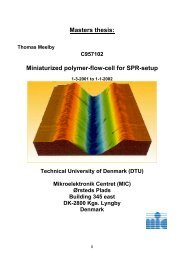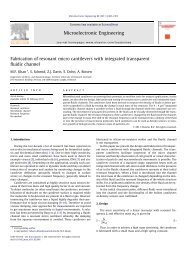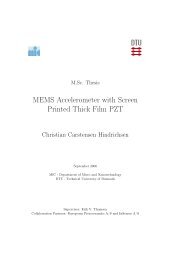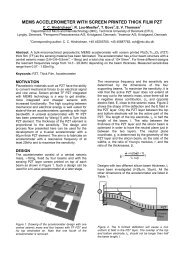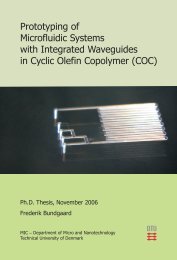C - DTU Nanotech - Danmarks Tekniske Universitet
C - DTU Nanotech - Danmarks Tekniske Universitet
C - DTU Nanotech - Danmarks Tekniske Universitet
Create successful ePaper yourself
Turn your PDF publications into a flip-book with our unique Google optimized e-Paper software.
18 3 Theoretical Considerations of Polymers for Bio-Microsystems<br />
CH 2<br />
CH3<br />
C<br />
C O<br />
OCH 3<br />
n<br />
Figure 3.1: Structure of PMMA [33]<br />
provided by a laser. Infrared laser machining evaporates substrate material directly by<br />
applying heat with the laser beam [35]. If UV radiation is used, the irradiated polymer<br />
decomposes, presumably by a mixture of two mechanisms: thermal and direct bond breaking<br />
[11]. As with infrared radiation, thermal bond breaking is induced by heat. In direct bond<br />
breaking, polymer molecules directly absorb ultraviolet photons so that the chemical bonds<br />
within the polymer chains will break if they absorb enough energy, which is often the case.<br />
The resulting smaller polymer chains are volatile or melt at much lower temperatures than<br />
the bulk polymer, thereby leaving a void in the material [11]. The smallest feature size<br />
attainable with laser machining depends strongly on the quality of the optical system, the<br />
laser wavelength and also the material properties of the polymer. As shown in equation 3.1<br />
for small feature sizes, short–wavelength radiation together with a high relative aperture of<br />
the optical system should be used.<br />
d = πλf<br />
4D<br />
d = Focal spot diameter<br />
λ = Wavelength<br />
f = Focal length<br />
D = Pre–focus diameter<br />
(3.1)<br />
From this the advantage of UV over infrared radiation can be seen: In practical terms<br />
the spot size that can be obtained with a UV system can be as small as 1.5 µm, whereas the<br />
feature size for an infrared laser is typically around 200 µm [2]. An advantage of the infrared<br />
laser is that fast prototyping is possible and it is available at moderate prices [35]. A disad-<br />
vantage of the infrared laser is, that the machined channels have Gaussian shape like shown<br />
in Fig. 3.2. For this research project only an infrared laser (CO2–laser, 1060 nm, Fig. 3.3)



